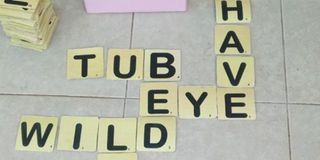Teach children to read and write early

Letters like these help train children to read and write because of continuous practice. Photo by Joan Salmon
The more you read, the better you get at it; the better you get at it, the more you like it; and the more you like it, the more you do it, says Jim Trelease, an educator and author who stresses reading aloud to children as a way to instil in them the love of literature.
While Trelease’s quote is so true for one that has already honed the skill and love for reading, it may not apply to toddlers, and even some older children. That would only imply that the onus is upon the guardians and parents to equip these little ones with the skills. Nonetheless, it is something we need to do with proficiency, seeing that these are building blocks for their future.
Rosey Sembatya, the proprietor of Malaika Mobile Library, says, “I understand proficiency as building a skill, in this case, the reading and writing skill.” A skill is generally built on practice but for a child, Crystal Rutangye, the proprietor of Scribe, and Sembatya believe that there are things that a parent ought to deliberately do.
There are windows of opportunity before the child turns seven to introduce habits and skills that you want them to have. For instance, making books available because children are always discovering. Sembatya points out that once they see a book, they will want to open it, and try to read.
Rutangye adds, “Do not force the children to read.” Everyone, children inclusive, hate things that are forced onto them. She cites an example of Beverly Namboozo of Babishai Niwe Poetry, who said, “I just let my children look at the books and flip the pages.”
You could even leave some books around that they can scribble in. Just let them get used to the idea of having books around them so that they naturally become part of the things they interact with daily.
Reading to the child
“It is important that this is regular because when children are younger; routine is crucial for emphasis,” Sembatya explains. This may be before bed time or any other time that you, as a family, make. You may not necessarily read the story as is, but look at the colourful pictures, and make stories out of them; sometimes based on what a child is familiar with.
“Children imitate,” Sembatya reminds parents. If a parent is seen reading, the child will want to have a book to read.
This is how the reading culture develops. It is, therefore, important that a deliberate time is set for reading.
If you choose to read to the child before bedtime or 30 minutes on a Sunday morning, let it be because children need routine.
Buy the right books
Find out what topics interest them, and buy them books about that. If your son likes cars, but him books about cars, for the younger children, books with much colour are the best. “It is so disheartening to be forced to read about something you are not interested in,” Rutangye says.
Games
Rutangye cites TWOG’s word games mostly to make literacy skills seem a fun game. TWOG is a Ugandan company that creates educational word games. The word games help both in reading and writing, because in the games, children compete to put words and letters to form words and sentences. Story boards are now being made to help in story formation.
Peer influence
Rutangye says parents should take children to children’s book clubs. There are several children’s book initiatives such as Malaika mobile library, Mixakids, Sooo many stories, and Babishai Niwe.
That aside, Scribe House partners with TWOG to do word games in schools, just to make spelling and sentence structure fun.
Parents can buy word games too.
These same methods can also help children get interested in writing, especially when they get the hang of verbal storytelling and realise that anything around them can be turned into a story.
They will want to express themselves with the written word too. Nonetheless, Rutangye says you could make it deliberate by giving them a journal, for example, to jot things in, for interested children, eight ages and above especially.
You could also tell them to narrate a story then challenge them to write it down. While these activities are helpful, they are ideal for children who already know how to read and write.
What to do
Above 10 but cannot read. If a child has got problems with spelling or can barely read, they probably do not know their sounds well so generally find it difficult to read and comprehend.
The solution to that is to go back to phonic books and take them through the basic sounds as we encourage and build confidence.
If they do not want to read. Rosey Sembatya, the proprietor of Malaika Mobile Library, says “does not want” means a parent did not nurture the interest when the child was younger. It is important that we focus on their strengths and build on them. Some children can enjoy books that are in the field they like, for example, a car loving child will enjoy looking at pictures of cars.
Native languages: Diana Lwanga, a mother passionate about teaching her children how to read their native language; Luganda despite living in the UK says, “I started this when my children were babies.
I would sing to them all the baby songs or nursery rhymes from home and their reaction would be satisfying.” Talking about why she believes teaching children to read in our native languages is important, Lwanga says, “English is not our first language. There are ways in which we express ourselves better in our language that we cannot in English.”




